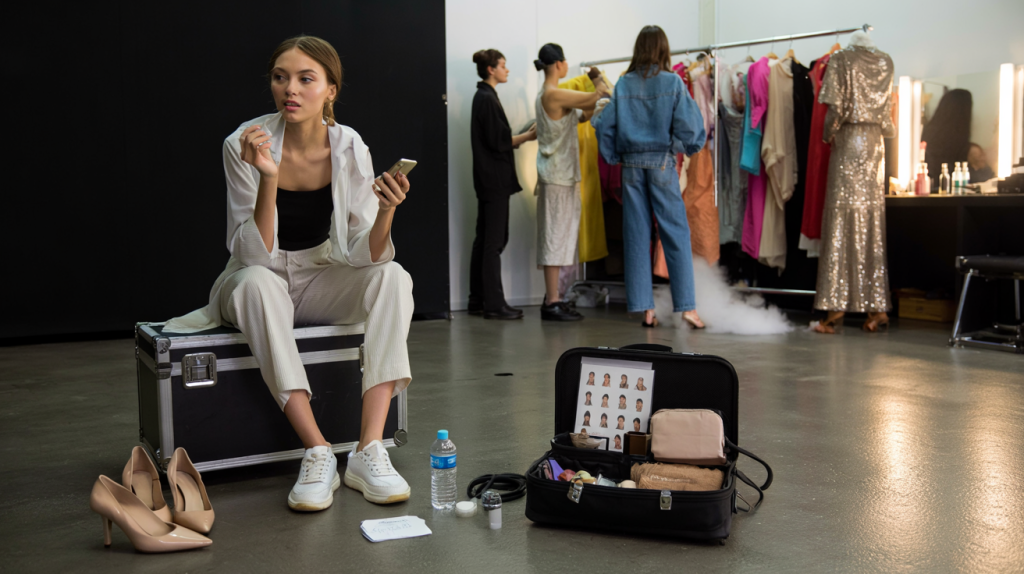From 4 cities in 4 weeks to last‑minute castings, discover the real daily life of fashion models, the rules that shape it and the smart habits that make it work.
The lights go out, the sequins settle, and the real shift begins. The daily life of fashion models is a mix of early calls, agency emails, relentless castings and strict timing, squeezed between skin care, fitness and content creation. Glamour shows up for a few minutes. The rest is logistics, stamina and resilience.
Twice a year, Fashion Month pulls models across New York, London, Milan and Paris over roughly four weeks, with calendars run by the CFDA, the British Fashion Council, Camera Nazionale della Moda Italiana and the Fédération de la Haute Couture et de la Mode. Between those peaks, there is commercial work, e‑commerce, editorials and constant preparation so the body, the face and the book are ready when a slot opens.
Inside the daily life of fashion models : routines and realities
Most days start with check‑ins from bookers, a look at call times, and a quick plan for transport and food. The job functions like a small business. Measurements are monitored, skin stays calm, hair remains camera ready, comp cards are updated, digitals are refreshed and shoes that fit the brief sit by the door.
The problem everyone whispers about is unpredictability. A fitting can turn into a six hour wait. A confirmed option can get dropped. Payment often routes through agencies and takes time. That means budgeting, saying yes to the right things and keeping energy when the day runs long.
Fashion Week rhythm : castings, fittings, call sheets and travel
During Fashion Month, a single day can bundle go‑sees, a rehearsal, then a late evening fitting for tomorrow’s look. Trains beat cars. Flats in the tote, heels in the bag. Snacks that do not stain. And yes, a portable phone charger becomes essential gear.
Under 18 models live a different schedule in New York. Since 2013, state law classifies under‑18 print and runway models as child performers, enforcing limited hours, on‑set chaperones and education provisions, with permits overseen by the New York State Department of Labor (2013 Child Model Law). That changed the backstage picture for teens, especially during New York Fashion Week.
Backstage etiquette is now more codified. The CFDA Health Initiative updated in 2017 reminds brands not to book models under 16 for runway and to provide reasonable breaks, private changing areas and nourishment during shows and shoots (CFDA, 2017). The message reached European weeks too, through brand policies and show notes.
Health, pay and rights : CFDA, Model Alliance and brand charters
Real protections grew after years of advocacy. The Model Alliance launched the Respect Program in 2018 to address harassment and power imbalances, signing partners from major groups and retailers (Model Alliance, 2018). The program set complaint channels and training, which nudged sets toward safer practices.
In 2017, LVMH et Kering introduced a joint Model Charter, committing to a minimum working age of 16 for runway and adult fashion shoots, to provide private changing spaces, to offer food and to ban the request for models to be dangerously underweight, along with medical certificate checks when needed (Model Charter, 2017). Those guidelines, while self‑regulated, reshaped casting calls and how long teams keep models on set.
Day to day, this translates into clear call sheets, better backstage areas and more attention to rest between looks. Rates and payment terms still vary by market and client. Models who track invoices, request detailed vouchers and confirm usage terms before stepping on set avoid the worst headaches later.
Smart habits models use to stay grounded
Here is what consistently keeps the wheels turning when schedules spike and energy dips.
- Plan the route the night before, with a backup line if trains stall.
- Carry simple, non‑messy snacks, a refillable bottle and basic first aid.
- Keep a clean digital portfolio and fresh digitals ready to email on the spot.
- Pack neutral underwear, skin‑tone heels, sneakers and a discreet robe for quick changes.
- Log every booking, voucher and expense in one place, then reconcile weekly.
- Know the rules : CFDA guidelines, the New York 2013 child model law, and the Model Charter help when a set goes off script.
- Protect recovery : short stretches, regular meals, screens off before sleep. The small things add up.
The analysis is simple. A model’s day balances performance, admin and self care, while navigating legal and brand rules set since 2013 and 2017. Add two fashion seasons a year across four cities and a growing need to create social content between bookings. The solution that actually works is pragmatic. Treat the career like a micro company, lean on the protections from the CFDA, Model Alliance and the LVMH et Kering charter when needed, and build routines that are flexible. The work looks effortless on the runway. Offstage, it is definitly planned.
